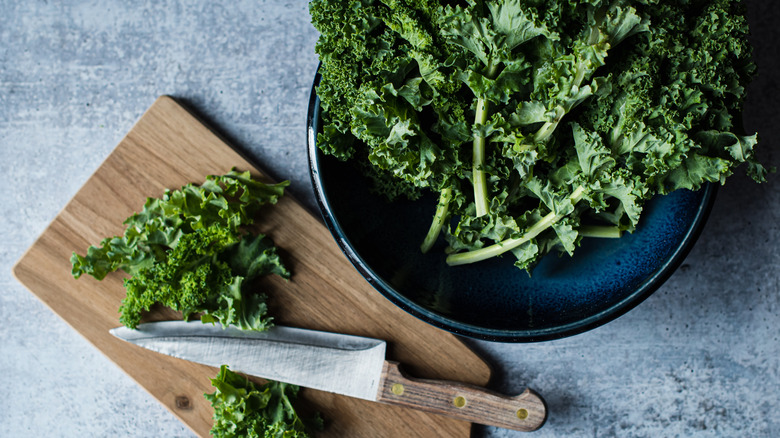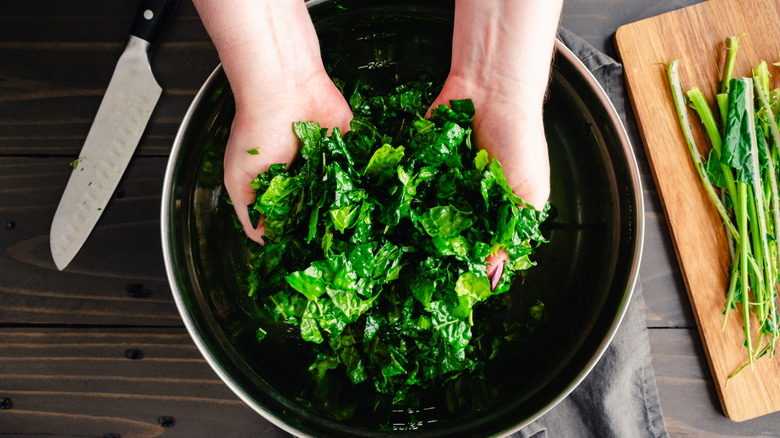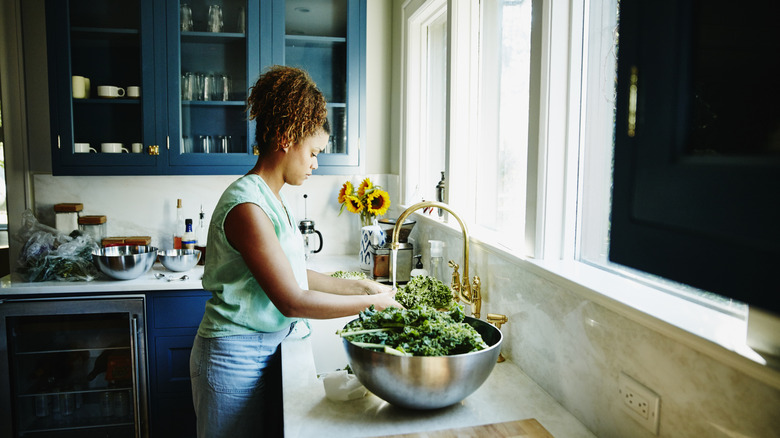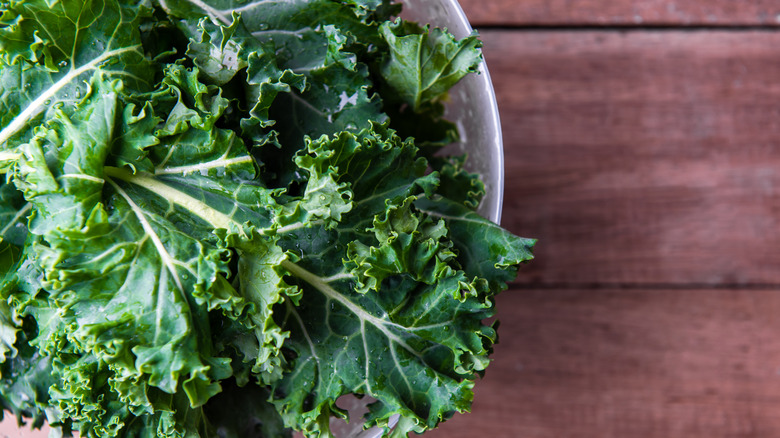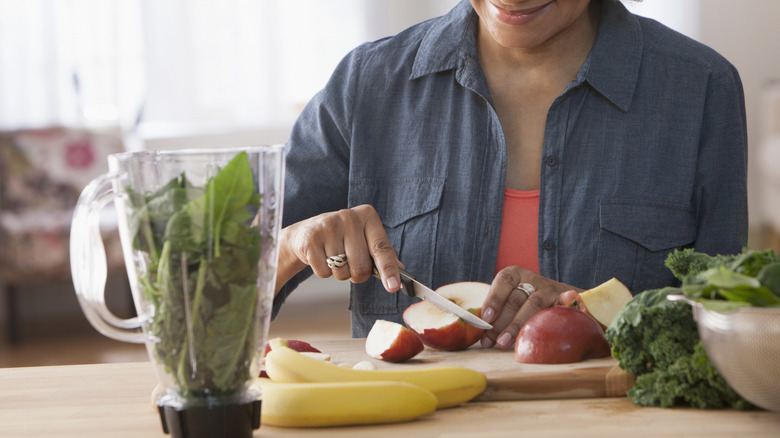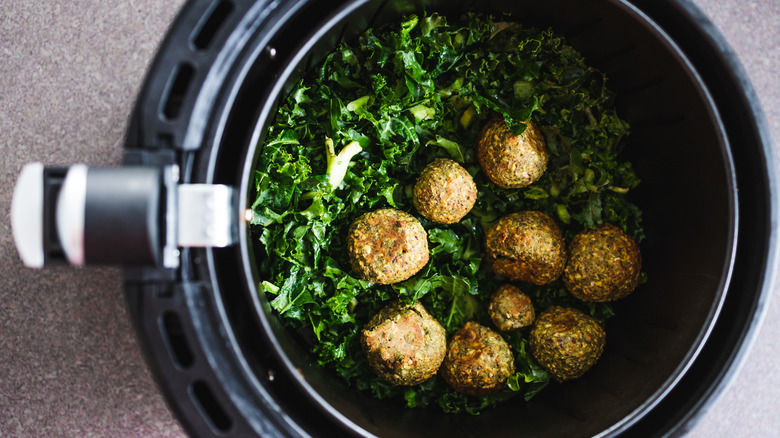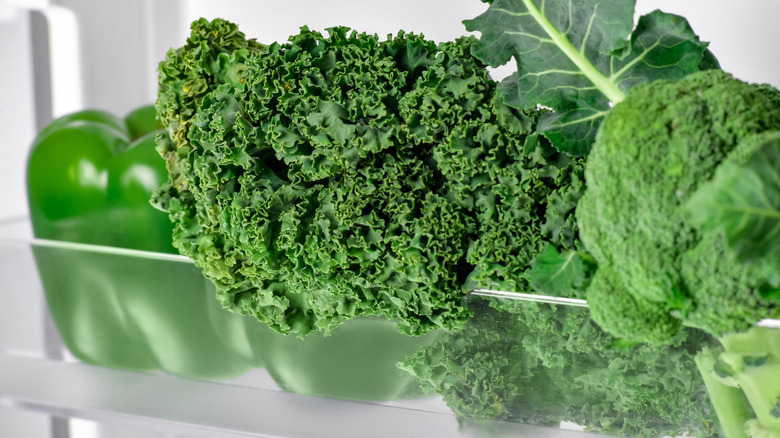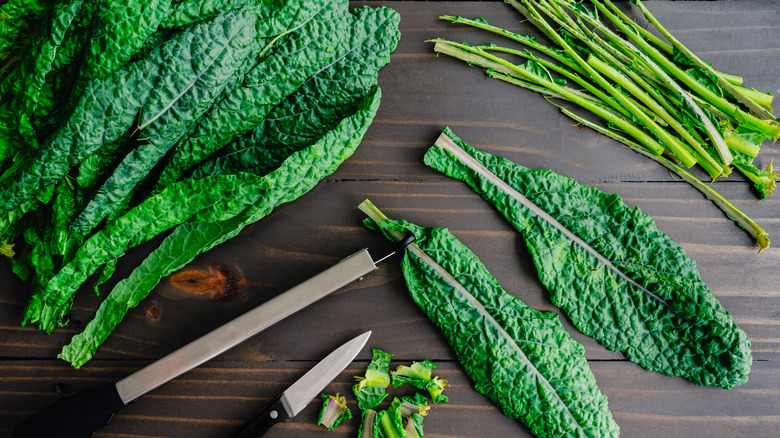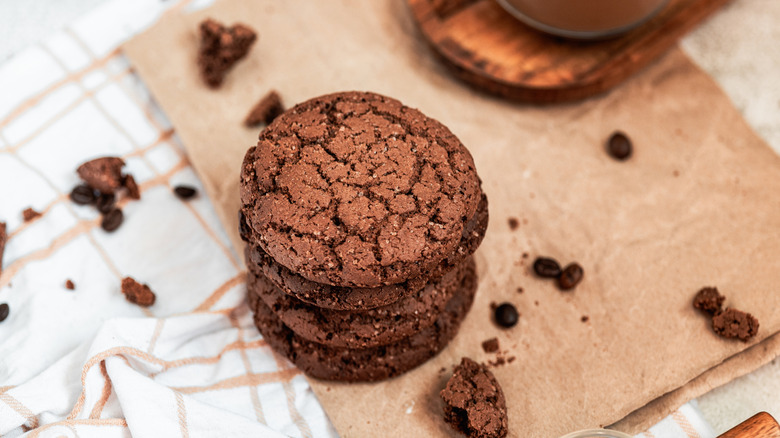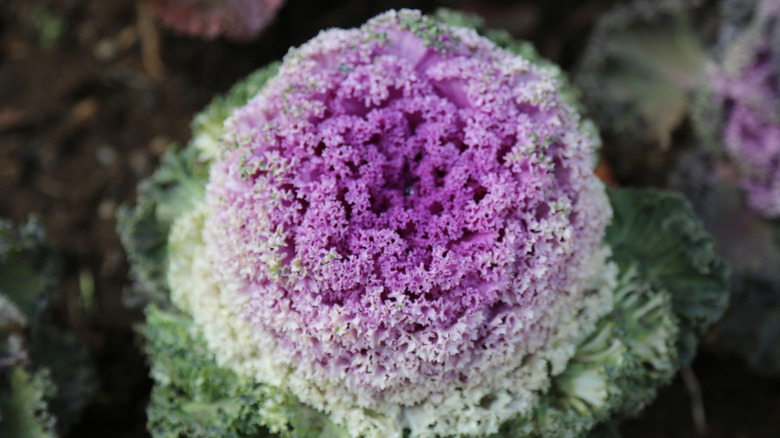10 Common Mistakes You've Been Making With Kale
Human beings have been eating leafy greens for centuries. They were a big part of the ancient Greek diet, for example, and the ancient Romans cultivated them, too. Today, people all over the world still eat leafy greens, but in the U.S., they could be eating many more. Research suggests that only one in 10 American adults eat enough fruits or vegetables, including leafy greens. This is a problem, because these foods are packed with essential nutrients, like vitamins and fiber.
Part of the problem with leafy greens, particularly fibrous, bitter ones, like kale, is that they are misunderstood. Without the right cooking technique, they can have a slightly unpleasant taste and a tough texture. But with the right cooking technique, everything changes. Massaging kale, pairing it with spicy or sweet ingredients, air-frying it, and baking it into cupcakes (yes, kale cupcakes are a thing) can transform a plain leafy green into an exciting cooking ingredient.
Looking for the perfect time to start enjoying kale? Fun fact: This leafy green even has its own day, which falls every year on the first Wednesday in October. But, of course, you don't need a special day to eat kale. It tastes good on all the other days of the year, too, especially if you know all the best ways to prepare it. Below, we've listed all the common mistakes people make with kale to help you take this simple nutrient-dense green to the next level. We've also got storage and essential hygiene tips, too.
Not massaging the kale
Kale is packed with fiber, and this is undeniably a positive thing for our health. One cup contains more than 5 grams of the nutrient, which benefits our gut and digestive health (and helps us to poop frequently). Generally, research suggests most adults should aim for around 25 to 30 grams of fiber day. A cup of kale gets you a good step closer to that goal, especially if it's combined with other fiber-dense vegetables, like spinach or peas.
But kale's fiber content does have one drawback — it means that the texture of this vegetable is rough, and well, fibrous. This makes it a little tough to chew and digest. But there is a solution to make kale a little easier on your mouth, teeth, and digestive system, and that's to massage it with something acidic, like lemon juice. Yep, just like humans, kale relaxes with a good massage. In scientific terms, the acid in the lemon will help to break down the texture of the leafy green, making it far easier to stomach. The juice will also help to reduce the bitter taste of kale, too.
But don't worry, you don't need to spend ages massaging your dinner. Just a few minutes should do the trick, and it'll make a big difference to the end result.
Not washing it before cooking
If you often eat leafy greens like kale straight from the plastic bag, it might be time to reconsider. This is because bacteria and pesticides can still be present on the leaves, so it's important to give them a good wash with fresh water (even if they are organic). The type of bacteria that can live on lettuce leaves can be harmful, think Salmonella or Listeria, both of which can cause serious illnesses, like salmonellosis and listeriosis. So, with that in mind, it's important to rinse off as much as you can before you start eating.
But before you rush to the fridge, it's also important to note that timing is everything with washing greens like kale. If you rinse them with water and then place them back in the fridge to store, they could actually end up picking up even more bacteria. Instead, it's best to wait to wash your kale until you're ready to cook with it. There is one exception to this: If your kale is pre-washed, leave it be. This is because, again, by adding more water you might actually increase the risk of bacteria contaminating it.
However, some choose not to buy pre-washed greens at all. This way, you can wash your kale safely at home without worrying about when it was washed, what it was washed with, and how many people may have touched it since.
Never freezing it to extend its life
Kale is usually bought fresh from the grocery store or farmer's market, but this doesn't mean you can't freeze it when you get home. Doing so will help to prolong the life of this leafy green, and help you cut down on unnecessary food waste (hands up if you've had to throw out a sad bag of limp greens from the back of the refrigerator in the past).
Freezing kale is easy. First, you'll need to wash and dry it — be careful not to leave too much moisture on it, because this will ultimately turn to ice in the freezer. After that, remove the leaves from the stem. You can do this by cutting them with a knife or simply using your hands to tear. After that, either pop them straight into the freezer in a freezer safe bag or Tupperware, or freeze them on a baking tray first before transitioning them back into the freezer in a bag.
Frozen kale is best used in dishes like soups, stews, and smoothies, but not dishes where you'll want a fresh leafy green, like a salad, for example. It will usually last up to six weeks before the quality starts to deteriorate, but if you want your frozen kale to last longer, you can also blanch it before freezing. This will stop the enzymes in the leaves from ripening, which is responsible for that bitter taste that develops in kale after a while.
Not balancing out its bitterness with spicy or sweet ingredients
Kale is undeniably nutritious. As well as fiber, this leafy green is also a source of vitamin C, vitamin K, manganese, vitamin A, and calcium, as well as antioxidants, like beta-carotene. Antioxidants are beneficial because they help to reduce free radical damage in the body, which can increase the risk of disease over time. This is why kale is ultimately a helpful addition to most people's diets.
However, one of the biggest things that puts people off kale is its bitter flavor. This is due to a certain compound in the leafy green called glucosinolates. It's also present in other bitter vegetables, like turnip greens, mustard greens, endive, and broccoli rabe. There are a few ways to reduce kale's bitterness. One easy way is to add different strong flavors into the mix to balance it out. You can add chilis, for example, or if you don't like the heat, you can mix it with a sweet ingredient, like fruit. Other sweet foods that pair well with kale include sweet potato, caramelized onions, honey, agave nectar, and maple syrup.
Other ways to dial down the bitterness of kale include soaking it in ice water, dousing the vegetable in vinaigrette with a high vinegar content, or blanching it before you eat it. Alternatively, you can buy varieties of kale that are known for being less bitter, like Tuscan kale, for example, which is a popular in Italy.
Never air-frying it
Air-fryers are a relatively new invention. They first hit the market in 2010, and since then, they have become a staple in homes all over the U.S. Research suggests that around 34% of Americans use one at least once a week. In 2023, the global market for the appliance was valued at more than $1.2 billion. The reason why air fryers are so popular is that they are so easy to use and versatile. You can cook many, many different foods in an air fryer, including vegetables, meats, fish, and yes, you guessed it, leafy greens like kale.
Popping your kale in the air fryer gives it a nice crispy texture, which is similar to potato chips. It's incredibly easy to do. Just grab your kale and mix it with olive oil and salt, alongside your go-to seasonings, before placing it in the air fryer for around 5 minutes (but keep on eye on it, you don't want your kale to burn). After that, it becomes a healthy snack for any time of day.
When it comes to seasoning choices, kale goes well with many flavors. Sea salt and garlic, for example, is a popular combination. You could also sprinkle it with cheesy nutritional yeast, or if you like spice, consider mixing your kale with some chili flakes or hot sauce. Other common ingredients to mix with kale include tahini, lemon juice, curry powder, almond butter, and cayenne pepper.
Not wrapping it in a paper towel in the fridge to prevent spoilage
Taking steps to help your food last longer is important for a few reasons. Firstly, it reduces food waste, which is a growing problem in the U.S. and around the world. In fact, research suggests that the U.S. throws away around 120 billion pounds of food every single year. Much of this comes from restaurants, hotels, and businesses, but households are also a significant contributor. On top of this, longer-lasting food also saves your wallet from having to buy more too soon.
If you don't want to freeze kale to prolong its shelf life, another option is to wrap it inside a paper towel before placing it in a plastic bag (or the bag it came in). It's simple, but very effective. The paper towel will help to absorb the moisture from the kale, which in turn will reduce the chance of it spoiling on you too soon.
Another way to help kale last longer is to completely dry it out. This means taking it out of the fridge and placing it in the oven to dehydrate (the process will last a few hours). After that, you can store the now-crispy kale in your pantry and use it as a topping for salads, pastas, or even just eat it straight out of the jar. Keep an eye on the color and the smell though, and make sure to dispose of it immediately if there are any signs of spoilage.
Throwing away the stems
Most people remove the leaves from kale and throw the stems away. This is because the stems of kale are tough, thick, and fibrous, with a stringy texture, which makes them harder to chew and digest. But if you don't want to throw them away, there are ways to make kale stems far more palatable (and reduce food waste in the process).
One option is to stir-fry the stems. As they cook, they will start to take on a more tender texture, which is far easier to eat. You can also pickle kale stems, or even deep-fry them and coat them in batter to make a crispy snack. Other options include turning them into pesto, adding them to a pasta sauce, or blitzing them into a juice or a smoothie. Fun fact: You can make all of these recipes with broccoli stems, too.
Eating kale stems doesn't just reduce waste, but it's also good for you. Like the leaves, the stems of this leafy green are packed with nutrients, including fiber and essential vitamins.
Only using it in salads
Kale salads have been in the mainstream since around 2007, when a New York Times column written by Melissa Clark praised a kale salad at a Brooklyn restaurant. That week, the column was called "If It Sounds Bad, It's Got to Be Good". Since then, the dish has grown in popularity, and now you'll find it in many different cafes across the U.S. and on the feeds of cooking influencers everywhere. If you search "kale salad" on TikTok, for example, you'll be met with many videos, some of which have racked up millions of views. But while there's nothing wrong with a kale salad (especially when it's covered in a flavor-packed dressing), this leafy green has so much potential beyond this one dish. In fact, one of the best things about kale is how versatile it is.
Kale works in many different recipes. As we've mentioned already, it can be crisped up in the air fryer or blended into smoothies or soups. It works particularly well in white bean soups, for example, with plenty of other vegetables, like carrots, celery, and baby potatoes. If you want a more meaty option, add your kale to an Instant Pot Italian wedding soup recipe with meatballs (these can also be swapped for vegan meatballs). Kale can also be baked in the oven as part of a sheet pan meal, for example, blended into creamy pasta sauces, or added to breakfast dishes like omelets or sweet potato hash.
Never adding it to dessert recipes
Speaking of how versatile kale is, did you know you can add it to dessert recipes? For fussy eaters, sneaking kale into sweet treats is a great way to hide the taste of the leafy green without missing out on all of its impressive health benefits. Kale is not just packed with nutrition, but it is also associated with lowering cholesterol levels (high cholesterol is associated with an increased risk of heart disease), reducing the risk of cancer, and supporting eye health.
You can mix kale into cupcake batter, for example. The flavor of other ingredients, like sugar, vanilla extract, and orange zest, will overpower the taste of the kale, and you'll be left with a bright green cupcake that tastes just as good as any other — just with added nutrition. You can also mix kale into the batter for chocolate cookies, fudge brownies, and even add it to cheesecake.
Kale can even be mixed into a frozen dessert that tastes like ice cream. One of the easiest ways to do this is to blend it up with ingredients like banana, nuts, honey, and ice in an ice cream maker. If you want your kale smoothie to still be a smoothie but want it to taste more like ice cream, simply blend all the same ingredients together with a little milk, and enjoy!
Not experimenting with different types
Kale tends to be lumped into one category, but this leafy green actually comes in many different varieties. One of the most common types of kale is curly kale, and this is probably the type you're thinking of when you imagine this leafy green. It has bright green leaves that curl at the ends, hence the name "curly" kale.
Other types of kale include Tuscan kale, for example, which, as mentioned earlier, has a nuttier, less bitter taste than other varieties. It's called Tuscan kale because it is often used in Italian cuisine, and was likely cultivated for the first time in Tuscany. Other names for Tuscan kale include lacinato kale or dinosaur kale. Kale isn't just part of Italian cuisine. In Russia, this leafy green isn't actually that green, but red. And for that reason, Russian varieties of kale are called red Russian kale. Again, this type of kale is a little sweeter than other varieties.
More common types of kale include scarlet kale (which is known for its vivid purple color), Beira kale, which looks like a cabbage and comes from Portugal (and is why it's sometimes referred to as Portuguese cabbage), and Darkibor kale. The latter is similar to curly kale, but the leaves are more tightly curled. One of the prettiest types of kale is Japanese flowering kale, which looks like a rose flower and has a bright pink and purple center with green leaves on the outside.
